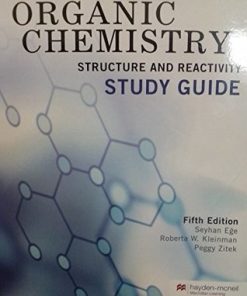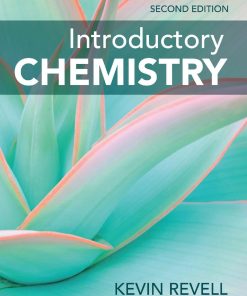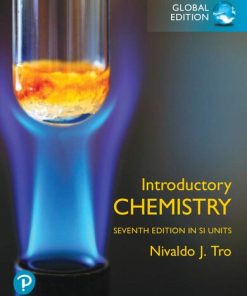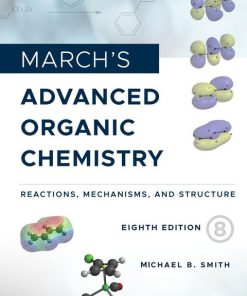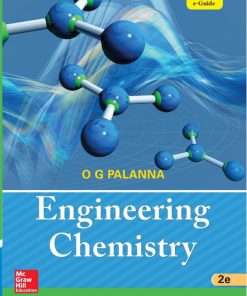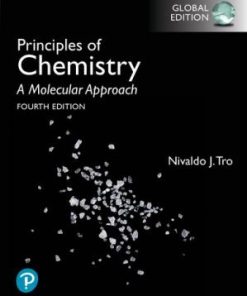Chemistry Structure and Properties Mastering Chemistry 2nd Edition by Nivaldo Tro 0134557301 9780134557304
$50.00 Original price was: $50.00.$25.00Current price is: $25.00.
Chemistry: Structure and Properties; Mastering Chemistry 2nd Edition by Nivaldo J. Tro – Ebook PDF Instant Download/DeliveryISBN: 0134557301, 9780134557304
Full download Chemistry: Structure and Properties; Mastering Chemistry 2nd Edition after payment.
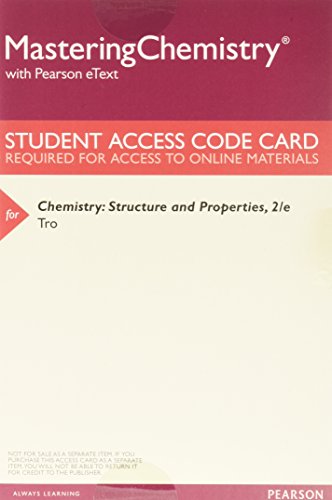
Product details:
ISBN-10 : 0134557301
ISBN-13 : 9780134557304
Author : Nivaldo J. Tro
This edition features the same content as the traditional text in a convenient, three-hole-punched, loose-leaf version. Books a la Carte also offer a great value; this format costs significantly less than a new textbook. Before purchasing, check with your instructor or review your course syllabus to ensure that you select the correct ISBN. Several versions of MyLab™ and Mastering™ platforms exist for each title, including customized…
Chemistry: Structure and Properties; Mastering Chemistry 2nd Table of contents:
Chapter 1 Atoms
1.1 A Particulate View of the World: Structure Determines Properties
1.2 Classifying Matter: A Particulate View
The States of Matter: Solid, Liquid, and Gas
Elements, Compounds, and Mixtures
1.3 The Scientific Approach to Knowledge
Creativity and Subjectivity in Science
1.4 Early Ideas about the Building Blocks of Matter
1.5 Modern Atomic Theory and the Laws That Led to It
The Law of Conservation of Mass
The Law of Definite Proportions
The Law of Multiple Proportions
John Dalton and the Atomic Theory
1.6 The Discovery of the Electron
Cathode Rays
Millikan’s Oil Drop Experiment: The Charge of the Electron
1.7 The Structure of the Atom
1.8 Subatomic Particles: Protons, Neutrons, and Electrons
Elements: Defined by Their Numbers of Protons
Isotopes: When the Number of Neutrons Varies
Ions: Losing and Gaining Electrons
1.9 Atomic Mass: The Average Mass of an Element’s Atoms
Mass Spectrometry: Measuring the Mass of Atoms and Molecules
1.10 Atoms and the Mole: How Many Particles?
The Mole: A Chemist’s “Dozen”
Converting between Number of Moles and Number of Atoms
Converting between Mass and Amount (Number of Moles)
1.11 The Origins of Atoms and Elements
Self-Assessment
Chapter Summary 1
Review
Key Learning Outcomes
Key Terms
Section 1.1
Section 1.2
Section 1.3
Section 1.5
Section 1.6
Section 1.7
Section 1.8
Section 1.9
Section 1.10
Key Concepts
Matter Is Particulate (1.1)
Classifying Matter Based on the Particles That Compose It (1.2)
The Scientific Approach to Knowledge (1.3)
Atomic Theory (1.5)
The Electron (1.6)
The Nuclear Atom (1.7)
Subatomic Particles (1.8)
Atomic Mass (1.9)
Atoms and the Mole (1.10)
Key Equations and Relationships
Exercises
Review Questions
Problems by Topic
The Classification of Matter
The Scientific Approach to Knowledge
The Laws of Conservation of Mass, Definite Proportions, and Multiple Proportions
Atomic Theory, Nuclear Theory, and Subatomic Particles
Isotopes and Ions
Atomic Mass and Mass Spectrometry
The Mole Concept
Cumulative Problems
Challenge Problems
Conceptual Problems
Questions for Group Work Active Classroom Learning
Data Interpretation and Analysis
Answers to Conceptual Connections
Chapter 2 The Quantum-Mechanical Model of the Atom
2.1 Schrödinger’s Cat
2.2 The Nature of Light
The Wave Nature of Light
The Electromagnetic Spectrum
Interference and Diffraction
The Particle Nature of Light
2.3 Atomic Spectroscopy and the Bohr Model
Atomic Spectra
The Bohr Model
Atomic Spectroscopy and the Identification of Elements
2.4 The Wave Nature of Matter: The de Broglie Wavelength, the Uncertainty Principle, and Indeterminacy
The de Broglie Wavelength
The Uncertainty Principle
Indeterminacy and Probability Distribution Maps
2.5 Quantum Mechanics and the Atom
Solutions to the Schrödinger Equation for the Hydrogen Atom
The Principal Quantum Number (n)
The Angular Momentum Quantum Number (l)
The Magnetic Quantum Number (ml)
The Spin Quantum Number (ms)
Atomic Spectroscopy Explained
2.6 The Shapes of Atomic Orbitals
s Orbitals (l = 0)
p Orbitals (l = 1)
d Orbitals (l = 2)
f Orbitals (l = 3)
The Phase of Orbitals
The Shape of Atoms
Self-Assessment
Chapter Summary 2
Review
Key Learning Outcomes
Key Terms
Section 2.1
Section 2.2
Section 2.3
Section 2.4
Section 2.5
Section 2.6
Key Concepts
The Realm of Quantum Mechanics (2.1)
The Nature of Light (2.2)
Atomic Spectroscopy (2.3)
The Wave Nature of Matter (2.4)
The Quantum-Mechanical Model of the Atom (2.5, 2.6)
Key Equations and Relationships
Exercises
Review Questions
Problems by Topic
Electromagnetic Radiation
The Wave Nature of Matter and the Uncertainty Principle
Orbitals and Quantum Numbers
Atomic Spectroscopy
Cumulative Problems
Challenge Problems
Conceptual Problems
Questions for Group Work Active Classroom Learning
Data Interpretation and Analysis
Answers to Conceptual Connections
Chapter 3 Periodic Properties of the Elements
3.1 Aluminum: Low-Density Atoms Result in Low-Density Metal
3.2 The Periodic Law and the Periodic Table
3.3 Electron Configurations: How Electrons Occupy Orbitals
Electron Spin and the Pauli Exclusion Principle
Sublevel Energy Splitting in Multi-electron Atoms
Coulomb’s Law
Shielding
Penetration
Electron Spatial Distributions and Sublevel Splitting
Electron Configurations for Multi-electron Atoms
3.4 Electron Configurations, Valence Electrons, and the Periodic Table
Orbital Blocks in the Periodic Table
Writing an Electron Configuration for an Element from Its Position in the Periodic Table
The Transition and Inner Transition Elements
3.5 Electron Configurations and Elemental Properties
Metals and Nonmetals
Families of Elements
The Formation of Ions
3.6 Periodic Trends in Atomic Size and Effective Nuclear Charge
Effective Nuclear Charge
Atomic Radii and the Transition Elements
3.7 Ions: Electron Configurations, Magnetic Properties, Radii, and Ionization Energy
Electron Configurations and Magnetic Properties of Ions
Ionic Radii
Ionization Energy
Trends in First Ionization Energy
Exceptions to Trends in First Ionization Energy
Trends in Second and Successive Ionization Energies
3.8 Electron Affinities and Metallic Character
Electron Affinity
Metallic Character
3.9 Periodic Trends Summary
Self-Assessment
Chapter Summary 3
Review
Key Learning Outcomes
Key Terms
Section 3.1
Section 3.2
Section 3.3
Section 3.4
Section 3.5
Section 3.6
Section 3.7
Section 3.8
Key Concepts
Periodic Properties and the Periodic Table (3.1, 3.2)
Electron Configurations (3.3)
Electron Configurations and the Periodic Table (3.4)
Electron Configurations and the Properties of Elements (3.5)
Effective Nuclear Charge and Periodic Trends in Atomic Size (3.6)
Ion Properties (3.7)
Electron Affinities and Metallic Character (3.8)
Key Equations and Relationships
Exercises
Review Questions
Problems by Topic
The Periodic Table
Electron Configurations
Valence Electrons and Simple Chemical Behavior from the Periodic Table
Coulomb’s Law and Effective Nuclear Charge
Atomic Radius
Ionic Electron Configurations, Ionic Radii, Magnetic Properties, and Ionization Energy
Electron Affinities and Metallic Character
Cumulative Problems
Challenge Problems
Conceptual Problems
Questions for Group Work Active Classroom Learning
Data Interpretation and Analysis
Answers to Conceptual Connections
Chapter 4 Molecules and Compounds
4.1 Hydrogen, Oxygen, and Water
4.2 Types of Chemical Bonds
4.3 Representing Compounds: Chemical Formulas and Molecular Models
Types of Chemical Formulas
Molecular Models
4.4 The Lewis Model: Representing Valence Electrons with Dots
4.5 Ionic Bonding: The Lewis Model and Lattice Energies
Ionic Bonding and Electron Transfer
Lattice Energy: The Rest of the Story
Ionic Bonding: Models and Reality
4.6 Ionic Compounds: Formulas and Names
Writing Formulas for Ionic Compounds
Naming Ionic Compounds
Naming Binary Ionic Compounds Containing a Metal That Forms Only One Type of Cation
Naming Binary Ionic Compounds Containing a Metal That Forms More Than One Type of Cation
Naming Ionic Compounds Containing Polyatomic Ions
Hydrated Ionic Compounds
4.7 Covalent Bonding: Simple Lewis Structures
Single Covalent Bonds
Double and Triple Covalent Bonds
Covalent Bonding: Models and Reality
4.8 Molecular Compounds: Formulas and Names
4.9 Formula Mass and the Mole Concept for Compounds
Molar Mass of a Compound
Using Molar Mass to Count Molecules by Weighing
4.10 Composition of Compounds
Mass Percent Composition as a Conversion Factor
Conversion Factors from Chemical Formulas
4.11 Determining a Chemical Formula from Experimental Data
Calculating Molecular Formulas for Compounds
Combustion Analysis
4.12 Organic Compounds
Self-Assessment
Chapter Summary 4
Review
Key Learning Outcomes
Key Terms
Section 4.2
Section 4.3
Section 4.4
Section 4.5
Section 4.6
Section 4.7
Section 4.9
Section 4.10
Section 4.11
Section 4.12
Key Concepts
Types of Chemical Bonds (4.2)
Representing Molecules and Compounds (4.3)
The Lewis Model (4.4)
Ionic Bonding (4.5)
Covalent Bonding (4.7)
Naming Inorganic Ionic and Molecular Compounds (4.6, 4.8)
Formula Mass and Mole Concept for Compounds (4.9)
Chemical Composition (4.10, 4.11)
Organic Compounds (4.12)
Key Equations and Relationships
Exercises
Review Questions
Problems by Topic
Types of Compounds and Chemical Formulas
Valence Electrons and Lewis Dot Structures
Ionic Bonding and Lattice Energy
Formulas and Names for Ionic Compounds
Simple Lewis Structures, Formulas, and Names for Molecular Compounds
Naming Compounds (When the Type Is Not Specified)
Formula Mass and the Mole Concept for Compounds
Composition of Compounds
Chemical Formulas from Experimental Data
Organic Compounds
Cumulative Problems
Challenge Problems
Conceptual Problems
Questions for Group Work Active Classroom Learning
Data Interpretation and Analysis
Answers to Conceptual Connections
Chapter 5 Chemical Bonding I Drawing Lewis Structures and Determining Molecular Shapes
5.1 Morphine: A Molecular Impostor
5.2 Electronegativity and Bond Polarity
Electronegativity
Bond Polarity, Dipole Moment, and Percent Ionic Character
5.3 Writing Lewis Structures for Molecular Compounds and Polyatomic Ions
Writing Lewis Structures for Molecular Compounds
Writing Lewis Structures for Polyatomic Ions
5.4 Resonance and Formal Charge
Resonance
Formal Charge
5.5 Exceptions to the Octet Rule: Odd-Electron Species, Incomplete Octets, and Expanded Octets
Odd-Electron Species
Incomplete Octets
Expanded Octets
5.6 Bond Energies and Bond Lengths
Bond Energy
Bond Length
5.7 VSEPR Theory: The Five Basic Shapes
Two Electron Groups: Linear Geometry
Three Electron Groups: Trigonal Planar Geometry
Four Electron Groups: Tetrahedral Geometry
Five Electron Groups: Trigonal Bipyramidal Geometry
Six Electron Groups: Octahedral Geometry
5.8 VSEPR Theory: The Effect of Lone Pairs
Four Electron Groups with Lone Pairs
Five Electron Groups with Lone Pairs
Six Electron Groups with Lone Pairs
5.9 VSEPR Theory: Predicting Molecular Geometries
Representing Molecular Geometries on Paper
Predicting the Shapes of Larger Molecules
5.10 Molecular Shape and Polarity
Polarity in Diatomic Molecules
Polarity in Polyatomic Molecules
Vector Addition
One Dimension
Two or More Dimensions
Self-Assessment
Chapter Summary 5
Review
Key Learning Outcomes
Key Terms
Section 5.2
Section 5.4
Section 5.5
Section 5.6
Section 5.7
Section 5.8
Key Concepts
Morphine: A Molecular Impostor (5.1)
Electronegativity and Bond Polarity (5.2)
Writing Lewis Structures of Molecular Compounds and Polyatomic Ions (5.3)
Resonance and Formal Charge (5.4)
Exceptions to the Octet Rule (5.5)
Bond Energies and Bond Lengths (5.6)
VSEPR Theory: Predicting Molecular Shape (5.7–5.9)
Molecular Shape and Polarity (5.10)
Key Equations and Relationships
Exercises
Review Questions
Problems by Topic
Electronegativity and Bond Polarity
Writing Lewis Structures, Resonance, and Formal Charge
Odd-Electron Species, Incomplete Octets, and Expanded Octets
Bond Energies and Bond Lengths
VSEPR Theory and Molecular Geometry
Molecular Shape and Polarity
Cumulative Problems
Challenge Problems
Conceptual Problems
Questions for Group Work Active Classroom Learning
Data Interpretation and Analysis
Answers to Conceptual Connections
Chapter 6 Chemical Bonding II Valence Bond Theory and Molecular Orbital Theory
6.1 Oxygen: A Magnetic Liquid
6.2 Valence Bond Theory: Orbital Overlap as a Chemical Bond
6.3 Valence Bond Theory: Hybridization of Atomic Orbitals
sp3 Hybridization
sp2 Hybridization and Double Bonds
sp Hybridization and Triple Bonds
sp3d and sp3d2 Hybridization
Writing Hybridization and Bonding Schemes
6.4 Molecular Orbital Theory: Electron Delocalization
Linear Combination of Atomic Orbitals (LCAO)
Second-Period Homonuclear Diatomic Molecules
Second-Period Heteronuclear Diatomic Molecules
6.5 Molecular Orbital Theory: Polyatomic Molecules
Self-Assessment
Chapter Summary 6
Review
Key Learning Outcomes
Key Terms
Section 6.2
Section 6.3
Section 6.4
Key Concepts
Valence Bond Theory (6.2, 6.3)
Molecular Orbital Theory (6.4, 6.5)
Key Equations and Relationships
Exercises
Review Questions
Problems by Topic
Valence Bond Theory
Molecular Orbital Theory
Cumulative Problems
Challenge Problems
Conceptual Problems
Questions for Group Work Active Classroom Learning
Data Interpretation and Analysis
Answers to Conceptual Connections
Chapter 7 Chemical Reactions and Chemical Quantities
7.1 Climate Change and the Combustion of Fossil Fuels
7.2 Chemical and Physical Change
7.3 Writing and Balancing Chemical Equations
7.4 Reaction Stoichiometry: How Much Carbon Dioxide?
Making Pizza: The Relationships among Ingredients
Making Molecules: Mole-to-Mole Conversions
Making Molecules: Mass-to-Mass Conversions
7.5 Stoichiometric Relationships: Limiting Reactant, Theoretical Yield, Percent Yield, and Reactant in Excess
Limiting Reactant and Yield
Reactant in Excess
7.6 Three Examples of Chemical Reactions: Combustion, Alkali Metals, and Halogens
Combustion Reactions
Alkali Metal Reactions
Halogen Reactions
Self-Assessment
Chapter Summary 7
Review
Key Learning Outcomes
Key Terms
Section 7.2
Section 7.3
Section 7.4
Section 7.5
Section 7.6
Key Concepts
Climate Change and the Combustion of Fossil Fuels (7.1)
Chemical Change (7.2)
Writing and Balancing Chemical Equations (7.3)
Reaction Stoichiometry (7.4)
Limiting Reactant, Theoretical Yield, Percent Yield, and Reactact in Excess (7.5)
Combustion, Alkali Metal, and Halogen Reactions (7.6)
Key Equations and Relationships
Exercises
Review Questions
Problems by Topic
Chemical and Physical Changes
Writing and Balancing Chemical Equations
Reaction Stoichiometry
Limiting Reactant, Theoretical Yield, Percent Yield, and Reactant in Excess
Combustion, Alkali Metal, and Halogen Reactions
Cumulative Problems
Challenge Problems
Conceptual Problems
Questions for Group Work Active Classroom Learning
Data Interpretation and Analysis
Answers to Conceptual Connections
Chapter 8 Introduction to Solutions and Aqueous Reactions
8.1 Molecular Gastronomy
8.2 Solution Concentration
Quantifying Solution Concentration
Using Molarity in Calculations
Solution Dilution
8.3 Solution Stoichiometry
8.4 Types of Aqueous Solutions and Solubility
Electrolyte and Nonelectrolyte Solutions
The Solubility of Ionic Compounds
8.5 Precipitation Reactions
8.6 Representing Aqueous Reactions: Molecular, Ionic, and Complete Ionic Equations
8.7 Acid–Base Reactions
Properties of Acids and Bases
Naming Binary Acids
Naming Oxyacids
Acid–Base Reactions
Acid–Base Titrations
8.8 Gas-Evolution Reactions
8.9 Oxidation–Reduction Reactions
Oxidation States
Identifying Redox Reactions
The Activity Series: Predicting Whether a Redox Reaction Is Spontaneous
Self-Assessment
Chapter Summary 8
Review
Key Learning Outcomes
Key Terms
Section 8.2
Section 8.4
Section 8.5
Section 8.6
Section 8.7
Section 8.8
Section 8.9
Key Concepts
Solution Concentration (8.2)
Solution Stoichiometry (8.3)
Aqueous Solutions and Precipitation Reactions (8.4, 8.5)
Equations for Aqueous Reactions (8.6)
Acid–Base Reactions (8.7)
Gas-Evolution Reactions (8.8)
Oxidation–Reduction Reactions (8.9)
Key Equations and Relationships
Exercises
Review Questions
Problems by Topic
Solution Concentration and Solution Stoichiometry
Types of Aqueous Solutions and Solubility
Precipitation Reactions
Ionic and Net Ionic Equations
Naming Acids
Acid–Base Reactions
Gas-Evolution Reactions
Oxidation and Reduction
Cumulative Problems
Challenge Problems
Conceptual Problems
Questions for Group Work Active Classroom Learning
Data Interpretation and Analysis
Answers to Conceptual Connections
Chapter 9 Thermochemistry
9.1 Fire and Ice
9.2 The Nature of Energy: Key Definitions
9.3 The First Law of Thermodynamics: There Is No Free Lunch
9.4 Quantifying Heat and Work
Heat
Temperature Changes and Heat Capacity
Thermal Energy Transfer
Work: Pressure–Volume Work
9.5 Measuring ΔE for Chemical Reactions: Constant-Volume Calorimetry
9.6 Enthalpy: The Heat Evolved in a Chemical Reaction at Constant Pressure
Exothermic and Endothermic Processes: A Particulate View
Stoichiometry Involving ΔH: Thermochemical Equations
9.7 Measuring ΔH for Chemical Reactions: Constant-Pressure Calorimetry
9.8 Relationships Involving ΔHrxn
9.9 Determining Enthalpies of Reaction from Bond Energies
9.10 Determining Enthalpies of Reaction from Standard Enthalpies of Formation
Standard States and Standard Enthalpy Changes
Calculating the Standard Enthalpy Change for a Reaction
9.11 Lattice Energies for Ionic Compounds
Calculating Lattice Energy: The Born–Haber Cycle
Trends in Lattice Energies: Ion Size
Trends in Lattice Energies: Ion Charge
Self-Assessment
Chapter Summary 9
Review
Key Learning Outcomes
Key Terms
Section 9.1
Section 9.2
Section 9.3
Section 9.4
Section 9.5
Section 9.6
Section 9.7
Section 9.8
Section 9.10
Section 9.11
Key Concepts
The Nature of Energy and Thermodynamics (9.1–9.3)
Heat and Work (9.4)
Enthalpy (9.6)
Calorimetry (9.5, 9.7)
Calculating ΔHrxn (9.8–9.10)
Lattice Energy (9.11)
Key Equations and Relationships
Exercises
Review Questions
Problems by Topic
Internal Energy, Heat, and Work
Heat, Heat Capacity, and Work
Enthalpy and Thermochemical Stoichiometry
Thermal Energy Transfer
Calorimetry
Quantitative Relationships Involving ΔH and Hess’s Law
Using Bond Energies to Calculate ΔHrxn
Enthalpies of Formation and ΔH
Lattice Energies
Cumulative Problems
Challenge Problems
Conceptual Problems
Questions for Group Work Active Classroom Learning
Data Interpretation and Analysis
Answers to Conceptual Connections
Chapter 10 Gases
10.1 Supersonic Skydiving and the Risk of Decompression
10.2 A Particulate Model for Gases: Kinetic Molecular Theory
10.3 Pressure: The Result of Particle Collisions
Pressure Units
The Manometer: A Way to Measure Pressure in the Laboratory
10.4 The Simple Gas Laws: Boyle’s Law, Charles’s Law, and Avogadro’s Law
Boyle’s Law: Volume and Pressure
Charles’s Law: Volume and Temperature
Avogadro’s Law: Volume and Amount (in Moles)
10.5 The Ideal Gas Law
The Ideal Gas Law Encompasses the Simple Gas Laws
Calculations Using the Ideal Gas Law
Kinetic Molecular Theory and the Ideal Gas Law
10.6 Applications of the Ideal Gas Law: Molar Volume, Density, and Molar Mass of a Gas
Molar Volume at Standard Temperature and Pressure
Density of a Gas
Molar Mass of a Gas
10.7 Mixtures of Gases and Partial Pressures
Deep-Sea Diving and Partial Pressures
Collecting Gases over Water
10.8 Temperature and Molecular Velocities
10.9 Mean Free Path, Diffusion, and Effusion of Gases
10.10 Gases in Chemical Reactions: Stoichiometry Revisited
Molar Volume and Stoichiometry
10.11 Real Gases: The Effects of Size and Intermolecular Forces
The Effect of the Finite Volume of Gas Particles
The Effect of Intermolecular Forces
Van der Waals Equation
Real Gas Behavior
Self-Assessment
Chapter Summary 10
Review
Key Learning Outcomes
Key Terms
Section 10.1
Section 10.2
Section 10.3
Section 10.4
Section 10.5
Section 10.6
Section 10.7
Section 10.9
Section 10.11
Key Concepts
Kinetic Molecular Theory (10.2)
Pressure (10.3)
The Simple Gas Laws (10.4)
The Ideal Gas Law (10.5, 10.6)
Mixtures of Gases and Partial Pressures (10.7)
Molecular Velocities and Effusion (10.8, 10.9)
Gas Stoichiometry (10.10)
Real Gases (10.11)
Key Equations and Relationships
Exercises
Review Questions
Problems by Topic
Converting between Pressure Units
Simple Gas Laws
Ideal Gas Law
Molar Volume, Density, and Molar Mass of a Gas
Partial Pressure
Molecular Velocities and Effusion
Reaction Stoichiometry Involving Gases
Real Gases
Cumulative Problems
Challenge Problems
Conceptual Problems
Questions for Group Work Active Classroom Learning
Data Interpretation and Analysis
Answers to Conceptual Connections
Chapter 11 Liquids, Solids, and Intermolecular Forces
11.1 Water, No Gravity
11.2 Solids, Liquids, and Gases: A Molecular Comparison
Properties of the States of Matter
Changes between States
11.3 Intermolecular Forces: The Forces That Hold Condensed States Together
Dispersion Force
Dipole–Dipole Force
Hydrogen Bonding
Ion–Dipole Force
11.4 Intermolecular Forces in Action: Surface Tension, Viscosity, and Capillary Action
Surface Tension
Viscosity
Capillary Action
11.5 Vaporization and Vapor Pressure
The Process of Vaporization
The Energetics of Vaporization
Vapor Pressure and Dynamic Equilibrium
Temperature Dependence of Vapor Pressure and Boiling Point
The Critical Point: The Transition to an Unusual State of Matter
11.6 Sublimation and Fusion
Sublimation
Fusion
Energetics of Melting and Freezing
11.7 Heating Curve for Water
11.8 Phase Diagrams
The Major Features of a Phase Diagram
Regions
Lines
The Triple Point
The Critical Point
Navigation within a Phase Diagram
The Phase Diagrams of Other Substances
11.9 Water: An Extraordinary Substance
Self-Assessment
Chapter Summary 11
Review
Key Learning Outcomes
Key Terms
Section 11.2
Section 11.3
Section 11.4
Section 11.5
Section 11.6
Section 11.8
Key Concepts
Solids, Liquids, and Intermolecular Forces (11.1, 11.2, 11.3)
Surface Tension, Viscosity, and Capillary Action (11.4)
Vaporization and Vapor Pressure (11.5, 11.7)
Fusion and Sublimation (11.6, 11.7)
Phase Diagrams (11.8)
The Uniqueness of Water (11.9)
Key Equations and Relationships
Exercises
Review Questions
Problems by Topic
Intermolecular Forces
Surface Tension, Viscosity, and Capillary Action
Vaporization and Vapor Pressure
Sublimation and Fusion
Phase Diagrams
The Uniqueness of Water
Cumulative Problems
Challenge Problems
Conceptual Problems
Questions for Group Work Active Classroom Learning
Data Interpretation and Analysis
Answers to Conceptual Connections
Chapter 12 Crystalline Solids and Modern Materials
12.1 Friday Night Experiments: The Discovery of Graphene
12.2 Crystalline Solids: Determining Their Structures by X-Ray Crystallography
12.3 Crystalline Solids: Unit Cells and Basic Structures
The Unit Cell
Closest-Packed Structures
12.4 Crystalline Solids: The Fundamental Types
Molecular Solids
Ionic Solids
Atomic Solids
12.5 The Structures of Ionic Solids
12.6 Network Covalent Atomic Solids: Carbon and Silicates
Carbon
Silicates
12.7 Ceramics, Cement, and Glass
Ceramics
Silicate Ceramics
Oxide Ceramics
Nonoxide Ceramics
Cement
Glass
12.8 Semiconductors and Band Theory
Molecular Orbitals and Energy Bands
Doping: Controlling the Conductivity of Semiconductors
12.9 Polymers and Plastics
Self-Assessment
Chapter Summary 12
Review
Key Learning Outcomes
Key Terms
Section 12.1
Section 12.2
Section 12.3
Section 12.4
Section 12.6
Section 12.7
Section 12.8
Section 12.9
Key Concepts
Crystalline Structures (12.2–12.3)
Types of Crystalline Solids (12.4)
Structure of Ionic Solids (12.5)
Network Covalent Atomic Solids (12.6)
Ceramics, Cement, and Glass (12.7)
Semiconductors and Band Theory (12.8)
Polymers and Plastics (12.9)
Key Equations and Relationships
Exercises
Review Questions
Problems by Topic
Types of Solids and Their Structures
Ceramics, Cement, and Glass
Semiconductors and Band Theory
Polymers
Cumulative Problems
Challenge Problems
Conceptual Problems
Questions for Group Work Active Classroom Learning
Data Interpretation and Analysis
Answers to Conceptual Connections
Chapter 13 Solutions
13.1 Antifreeze in Frogs
13.2 Types of Solutions and Solubility
Nature’s Tendency toward Mixing: Entropy
The Effect of Intermolecular Forces
13.3 Energetics of Solution Formation
Energy Changes in Solution Formation
Aqueous Solutions and Heats of Hydration
13.4 Solution Equilibrium and Factors Affecting Solubility
The Effect of Temperature on the Solubility of Solids
Factors Affecting the Solubility of Gases in Water
The Effect of Temperature
The Effect of Pressure
13.5 Expressing Solution Concentration
Molarity
Molality
Parts by Mass and Parts by Volume
Mole Fraction and Mole Percent
13.6 Colligative Properties: Vapor Pressure Lowering, Freezing Point Depression, Boiling Point Elevation, and Osmotic Pressure
Vapor Pressure Lowering
Vapor Pressures of Solutions Containing a Volatile (Nonelectrolyte) Solute
Freezing Point Depression and Boiling Point Elevation
Osmotic Pressure
13.7 Colligative Properties of Strong Electrolyte Solutions
Strong Electrolytes and Vapor Pressure
Colligative Properties and Medical Solutions
Self-Assessment
Chapter Summary 13
Review
Key Learning Outcomes
Key Terms
Section 13.1
Section 13.2
Section 13.3
Section 13.4
Section 13.5
Section 13.6
Section 13.7
Key Concepts
Solutions (13.1, 13.2)
Solubility and Energetics of Solution Formation (13.2, 13.3)
Solution Equilibrium (13.4)
Concentration Units (13.5)
Vapor Pressure Lowering, Freezing Point Depression, Boiling Point Elevation, and Osmosis (13.6, 13.7)
Key Equations and Relationships
Exercises
Review Questions
Problems by Topic
Solubility
Energetics of Solution Formation
Solution Equilibrium and Factors Affecting Solubility
Concentrations of Solutions
Vapor Pressure of Solutions
Freezing Point Depression, Boiling Point Elevation, and Osmosis
Cumulative Problems
Challenge Problems
Conceptual Problems
Questions for Group Work Active Classroom Learning
Data Interpretation and Analysis
Answers to Conceptual Connections
Chapter 14 Chemical Kinetics
14.1 Catching Lizards
14.2 Rates of Reaction and the Particulate Nature of Matter
The Concentration of the Reactant Particles
The Temperature of the Reactant Mixture
The Structure and Orientation of the Colliding Particles
14.3 Defining and Measuring the Rate of a Chemical Reaction
Defining Reaction Rate
Change in Reactant and Product Concentrations
The Average Rate of the Reaction
The Instantaneous Rate of the Reaction
Measuring Reaction Rates
14.4 The Rate Law: The Effect of Concentration on Reaction Rate
Reaction Orders
Zero-Order Reaction
First-Order Reaction
Second-Order Reaction
Determining the Order of a Reaction
Reaction Order for Multiple Reactants
14.5 The Integrated Rate Law: The Dependence of Concentration on Time
Integrated Rate Laws
First-Order Integrated Rate Law
Second-Order Integrated Rate Law
Zero-Order Integrated Rate Law
The Half-Life of a Reaction
First-Order Reaction Half-Life
Second-Order Reaction Half-Life
Zero-Order Reaction Half-Life
14.6 The Effect of Temperature on Reaction Rate
The Arrhenius Equation
The Activation Energy
The Frequency Factor
The Exponential Factor
Arrhenius Plots: Experimental Measurements of the Frequency Factor and the Activation Energy
The Collision Model: A Closer Look at the Frequency Factor
14.7 Reaction Mechanisms
Rate Laws for Elementary Steps
Rate-Determining Steps and Overall Reaction Rate Laws
Mechanisms with a Fast Initial Step
14.8 Catalysis
Homogeneous and Heterogeneous Catalysis
Enzymes: Biological Catalysts
Self-Assessment
Chapter Summary 14
Review
Key Learning Outcomes
Key Terms
Section 14.4
Section 14.5
Section 14.6
Section 14.7
Section 14.8
Key Concepts
Reaction Rates (14.1–14.3)
Reaction Rate Laws and Orders (14.4)
Integrated Rate Laws and Half-Life (14.5)
The Effect of Temperature on Reaction Rate (14.6)
Reaction Mechanisms (14.7)
Catalysis (14.8)
Key Equations and Relationships
Exercises
Review Questions
Problems by Topic
Reaction Rates
The Rate Law and Reaction Orders
The Integrated Rate Law and Half-Life
The Effect of Temperature and the Collision Model
Reaction Mechanisms
Catalysis
Cumulative Problems
Challenge Problems
Conceptual Problems
Questions for Group Work Active Classroom Learning
Data Interpretation and Analysis
Answers to Conceptual Connections
People also search for Chemistry: Structure and Properties; Mastering Chemistry 2nd:
chemistry physical and chemical properties
chemistry structure and properties quizlet
chemistry structure and properties answers
chemistry structure and properties – modified access
chemistry structure and properties
Tags: Chemistry, Structure, Properties, Mastering Chemistry, Nivaldo Tro
You may also like…
Chemistry - Chemistry - General & Miscellaneous
Chemistry - Organic Chemistry
Organic Chemistry: Structure and Reactivity Study Guide 5th Edition Seyhan Ege
Chemistry - Chemistry - General & Miscellaneous
Introductory Chemistry 2nd Edition Kevin 1319383831 9781319383831
Chemistry - Chemistry - General & Miscellaneous
Engineering - Chemical Engineering
Chemistry - Microchemistry





